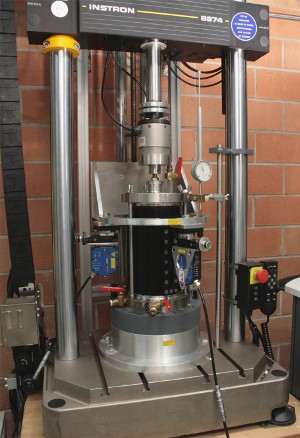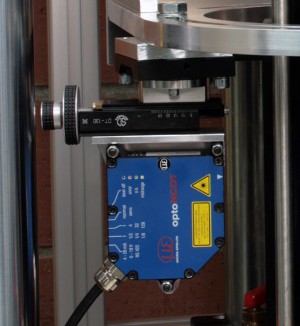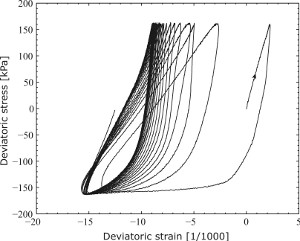Non linear soil behaviour
Sand is a material known to behave nonlinearly under cyclic and dynamic loading, such as earthquake-induced wave propagation. Cyclic loading in undrained conditions induces a decrease of the stiffness and an increase of the pore pressure, ultimately causing sand failure by cyclic mobility or liquefaction. The characterization and modelling of such behaviour is a critical issue, as earthquakes remain strongly hazardous in terms of human lives and destructions of all types of structures.
In particular, the quantification of the effect of loading features on the nonlinear soil behaviour is not well known. The dynamic triaxial press of LMS allows addressing cyclic nonlinear soil behaviour under various loading conditions. This advanced testing device was funded by a R’Equip research grant and an EPFL allowance.
The dynamic triaxial cell INSTROM 8874
 |
 |
| Picture of the dynamic triaxial press | Detailed view of a laser sensor for radial strain monitoring |
The triaxial press INSTRON 8874 is a biaxial servohydraulic dynamic testing system. A special triaxial cell has been designed to suit the apparatus. The device imposes three different cyclic motions (axial loading, confining pressure and rotation along the vertical axis) by a unique feedback control system; it also performs automatic data acquisition. Cyclic compression and extension are performed in stress-controlled mode; a sinusoidal deviatoric stress of constant amplitude is applied to the sample. Such loadings are very important in earthquake engineering, because they much more easily lead to cyclic mobility or liquefaction and give a better representation of earthquake loading in the shear plane.
The dynamic triaxial press is equipped with a specifically designed cell pierced by three glass windows, which allow measuring the diameter through glass and water layer with non-contact sensors. There are three laser sensors positioned outside the cell. They record the displacement of the sample surface thanks to diffuse reflection. The three lasers are mounted on a structure which can move vertically, and can thus scan the profile of the cylindrical soil sample.
Some results: Leman sand cyclic behaviour
Sand samples are loaded in cyclic undrained stress-controlled conditions to determine dynamic parameters at medium to large strain level. The effect of the superposition of compressive and shear cyclic load can be analyzed under different stress-path. The experimental results are also used to calibrate constitutive models, such as simple the linear equivalent model or an advanced elastoplastic model.

Dry cyclic test on dense Leman sand